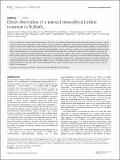Direct observation of a uniaxial stress-driven Lifshitz transition in Sr2RuO4
Abstract
Pressure represents a clean tuning parameter for traversing the complex phase diagrams of interacting electron systems, and as such has proved of key importance in the study of quantum materials. Application of controlled uniaxial pressure has recently been shown to more than double the transition temperature of the unconventional superconductor Sr2RuO4, leading to a pronounced peak in Tc versus strain whose origin is still under active debate. Here we develop a simple and compact method to passively apply large uniaxial pressures in restricted sample environments, and utilise this to study the evolution of the electronic structure of Sr2RuO4 using angle-resolved photoemission. We directly visualise how uniaxial stress drives a Lifshitz transition of the γ-band Fermi surface, pointing to the key role of strain-tuning its associated van Hove singularity to the Fermi level in mediating the peak in Tc. Our measurements provide stringent constraints for theoretical models of the strain-tuned electronic structure evolution of Sr2RuO4. More generally, our experimental approach opens the door to future studies of strain-tuned phase transitions not only using photoemission but also other experimental techniques where large pressure cells or piezoelectric-based devices may be difficult to implement.
Citation
Sunko , V , Morales , E A , Marković , I , Barber , M E , Milosavljević , D , Mazzola , F , Sokolov , D A , Kikugawa , N , Cacho , C , Dudin , P , Rosner , H , Hicks , C W , King , P D C & Mackenzie , A P 2019 , ' Direct observation of a uniaxial stress-driven Lifshitz transition in Sr 2 RuO 4 ' , npj Quantum Materials , vol. 4 , 46 . https://doi.org/10.1038/s41535-019-0185-9
Publication
npj Quantum Materials
Status
Peer reviewed
ISSN
2397-4648Type
Journal article
Description
Funding: We gratefully acknowledge support from the European Research Council (Grant No. ERC-714193-QUESTDO), the Royal Society, EPSRC for PhD studentship support through grant number EP/L015110/1 (VS).Collections
Items in the St Andrews Research Repository are protected by copyright, with all rights reserved, unless otherwise indicated.

